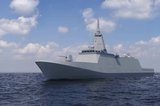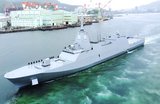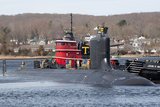RFA Support Ships pass design review stage
The FSS fleet will support the RFA’s function for the Royal Navy. (Image: Credit MoD)
The UK Royal Fleet Auxiliary’s (RFA) Fleet Solid Support Ships (FSS) programme has completed its Preliminary Design Review (PDR), its first major milestone en route to construction in 2025.
The PDR work was a collaborative effort between Defence Equipment and Support (DE&S), Navantia UK and UK designer BMT, with the latter leading the functional design phase.
The UK Ministry of Defence said the Fleet Solid Support Programme would “deliver highly capable ships for the Royal Fleet Auxiliary”, and would now focus on meeting its production deadlines throughout 2025.
Related Articles
Row erupts over expected international tender for UK FSS programme
UK selects Harland & Wolff, Navantia and BMT team for support ships
New UK support ships to go ahead, LPDs to remain in service
The completion of the PDR comes after the ships, which were first mooted in 2015, faced delays in development. The programme was placed on hold in 2019 and not restarted until 2021, at least partly due to complications as a result of the Covid-19 pandemic. The three FSS vessels were eventually contracted for construction in January 2023, with a price tag of £1.6 billion (US$2 billion).
The Fleet Solid Support ships will be designed to deliver crucial munitions, supplies and provisions to Royal Navy warships while they are at sea. They will also provide logistical and operational support, even on counter-piracy and counter-terrorism missions.
Each of the FSS ships will have a core RFA crew of 101, with accommodation provided for an additional 80 personnel operating helicopters, boats or performing other roles as required.
They will also take the Royal Navy’s ecological responsibilities seriously, being designed with an eye to minimised carbon emissions, and equipped with energy-efficient technologies to decrease power consumption. The vessels will be adaptable, to reduce their carbon footprint by using low-carbon, non-fossil fuels, and future sustainable energy sources. They are intended to achieve a Carbon Zero status by the end of their 30-year operational lifespan.
The three FSS vessels are expected to enter active service in 2032, and their predecessor, the RFA Fort Victoria, which will continue to provide solid support ship availability during the capability transition period of the FSS ships.
Related Programmes in Defence Insight
Fleet Solid Support (FSS) (1-3) [UK]
Related Equipment in Defence Insight
More from Naval Warfare
-
![Thales’ new Sonar 76Nano could equip UK Royal Navy on anti-submarine warfare missions]()
Thales’ new Sonar 76Nano could equip UK Royal Navy on anti-submarine warfare missions
The new sonar is designed to equip uncrewed underwater vessels, with the potential to be used by the Royal Navy for its Atlantic Bastion and Atlantic Net missions.
-
![Hanwha wins Australian government approval to increase its stake in Austal]()
Hanwha wins Australian government approval to increase its stake in Austal
The contract would mean the two shipbuilders can collaborate strategically and enhance shipbuilding capabilities in Western Australia.
-
![UK to join US Navy’s Virginia-class submarine assembly effort to speed up construction]()
UK to join US Navy’s Virginia-class submarine assembly effort to speed up construction
The expansion of the Virginia-class submarine construction to UK shores could accelerate the project as US shipbuilders continue to fall short of delivery goals.






















